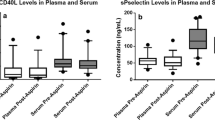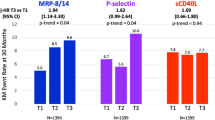Abstract
It has been reported that platelet expression and plasma levels of soluble P-selectin are increased in patients with unstable coronary artery syndromes. However, the origin of soluble P-selectin remains unknown. We sought to determine whether platelet expression of P-selectin correlates with plasma levels in the population of patients presenting to the emergency department with chest pain. In 338 patients presenting with chest pain to the emergency departments of three different hospitals, simultaneous soluble and platelet P-selection levels were determined using enzyme-linked immunosorbent assay (ELISA) and whole blood flow cytometry, respectively. Using regression analysis no correlation (R2=0.055) was found between soluble and platelet-bound P-selectin for the study population, including those patients with noncardiac chest pain (R2=0.019), unstable angina (R2=0.007), acute myocardial infraction (R2=0.033), congestive heart failure (R2=0.231), and gastrointestinal illness (R2=0.020). The platelet expression of P-selectin is unrelated to the level found in plasma in patients with acute chest pain, irrespective of the etiology of chest pain. Dissociation between platelet and soluble P-selectin suggests that the soluble form cannot serve as a surrogate marker to indicate platelet activation in the chest pain population.
Similar content being viewed by others
References
Davies MJ, Thomas AC, Knapman PA, Hangarter JR. Intramyocardial platelet aggregation in patients with acute myocardial infarction suffering sudden ischemic cardiac death. Circulation 1986;73:418-427.
Kereiakes DJ. Preferential benefit of platelet glycoprotein IIb/IIIa receptor blockade: Specic considerations by device and disease stage. Am J Cardiol 1998;81:49E-54E.
Johnston GI, Bliss GA, Newman PJ, McEver RP. Structure of the human gene encoding granule membrane protein-140, a member of the selectin family of adhesion receptors for leukocytes. J Biol Chem 1990;265:21381-21385.
Gearing AJH, Newman W. Circulating adhesion molecules in disease. Immunol Today 1993;14:506-512.
Gurbel PA, Serebruany VL. Myths and realities of plasma P-selectin levels in patients with acute myocardial infarction. Thromb Res 1997;88:343-344.
Sakurai S, Inoue A, Koh CS, Owa M, Yanagisawa N. Soluble form of selectins in blood of patients with acute myocardial infarction and coronary intervention. Vasc Med 1997;2:163-168.
Tedder TF, Steeber DA, Chen A, Engel P. The selectins: Vascular adhesion molecules. FASEB J 1995;9:866-873.
Verhaar MC, Beutler JJ, Gaillard CA, Koomans HA, Fijnheer R, Rabelink TJ. Progressive vascular damage in hypertension is associated with increased levels of circulating P-selectin. J Hypertens 1998;16:45-50.
Massberg S, Enders G, Leiderer R, et al. Platelet-endothelial cell interactions during ischemia/reperfusion: The role of P-selectin. Blood 1998;92:507-515.
Ikeda H, Takajo Y, Ichiki K, et al. Increased soluble form of P-selectin in patients with unstable angina. Circulation 1995;92:1693-1696.
Kaikita K, Ogawa H, Yasue H, et al. Soluble P-selectin is released into the coronary circulation after coronary spasm. Circulation 1995;92:1726-1730.
Ikeda H, Nakayama H, Oda T, et al. Soluble form of P-selectin in patients with acute myocardial infarction. Coron Artery Dis 1994;5:515-518.
Kumar A, Hoover JL, Simmons CA, Lindner V, Shebuski RJ. Remodeling and neointimal formation in the carotid artery of normal and P-selectin-deficient mice. Circulation 1997;96:4333-4342.
Frenette PS, Wagner DD. Insights into selectin function from knockout mice. Thromb Haemost 1997;78:60-64.
Minamino T, Kitakaze M, Asanuma H, et al. Endogenous adenosine inhibits P-selectin-dependent formation of coronary thromboemboli during hypoperfusion in dogs. J Clin Invest 1998;101:1643-1653.
Michelson AD, Barnard MR, Hechtman HB, et al. In vivo tracking of platelets: Circulating degranulated platelets rapidly lose surface P-selectin but continue to circulate and function. Proc Natl Acad Sci U S A 1996;93:11877-11882.
Jy W, Horstman LL, Park H, Mao WW, Valant P, Ahn YS. Platelet aggregates as markers of platelet activation: Characterization of flow cytometric method suitable for clinical applications. Am J Hematol 1998;57:33-42.
Knight CJ, Panesar M, Wright C, et al. Altered platelet function detected by flow cytometry. Effects of coronary artery disease and age. Arterioscler Thromb Vasc Biol 1997;17:2044-2053.
Yamada K, Tojo SJ, Hayashi M, Morooka S. The role of P-selectin, sialyl Lewis X and sulfatide in myocardial ischemia and reperfusion injury. Eur J Pharmacol 1998;346:217-225.
Serebruany VL, Gurbel PA. Assessment of platelet activity by measuring platelet-derived substances in plasma from patients with acute myocardial infarction: Surprising lessons from the GUSTO-III Platelet Study. Thromb Res 1999;93:149-150.
Serebruany VL, Gurbel PA. Effect of thrombolytic therapy on the plasma concentration and platelet expression of the platelet/endothelial cell adhesion P-selectin in Patients with Chest Pain 21 molecule in patients with acute myocardial infarction. Arterioscler Thromb Vasc Biol 1999;19:153-158.
Gurbel PA, Kereiakes DJ, Dalesandro MR, Bahr RD, O'Connor CM, Serebruany VL. The role of soluble and platelet-bound P-selectin in discriminating cardiac from non-cardiac chest pain at presentation in the emergency department. Am Heart J 2000;139:320-328.
Fox JE. Shedding of adhesion receptors from the surface of activated platelets. Blood Coagul Fibrinolysis 1994;5:291-304.
Heijnen HF, Schiel AE, Fijnheer R, Geuze HJ, Sixma JJ. Activated platelets release two types of membrane vesicles: Microvesicles by surface shedding and exosomes derived from exocytosis of multivesicular bodies and alpha-granules. Blood 1999;94:3791-3799.
Author information
Authors and Affiliations
Rights and permissions
About this article
Cite this article
Gurbel, P.A., Kereiakes, D.J. & Serebruany, V.L. Soluble P-selectin Is Not a Surrogate Marker for Platelet P-selectin: Evidence from a Multicenter Chest Pain Study Group. J Thromb Thrombolysis 10, 15–22 (2000). https://doi.org/10.1023/A:1018738502654
Issue Date:
DOI: https://doi.org/10.1023/A:1018738502654




